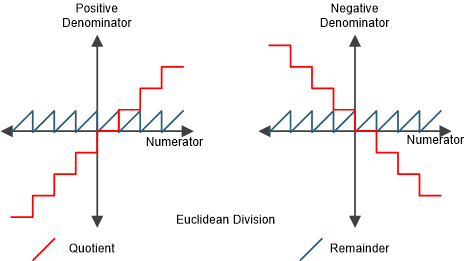SPRACN6 July 2019 F29H850TU , F29H859TU-Q1 , TMS320F28384D , TMS320F28384D-Q1 , TMS320F28384S , TMS320F28384S-Q1 , TMS320F28386D , TMS320F28386D-Q1 , TMS320F28386S , TMS320F28386S-Q1 , TMS320F28388D , TMS320F28388S , TMS320F28P550SG , TMS320F28P550SJ , TMS320F28P559SG-Q1 , TMS320F28P559SJ-Q1 , TMS320F28P650DH , TMS320F28P650DK , TMS320F28P650SH , TMS320F28P650SK , TMS320F28P659DH-Q1 , TMS320F28P659DK-Q1 , TMS320F28P659SH-Q1
2.3 Euclidean Division
This form of division is derived from Euclid’s theorem. The quotient and remainder results are defined as follows:
if (Denominator > 0)
Quotient = floor(Numerator/Denominator)
else if(Denominator < 0)
Quotient = ceil(Numerator/Denominator)
The transfer function of Euclidean division is shown in Figure 3. The remainder is always positive in Euclidean division. The division function is linear around the zero point and the modulo function is periodic. Due to its unique properties, it is preferred for implementing several algorithms.
 Figure 3. Euclidean Division Function
Figure 3. Euclidean Division Function The quotient and remainder results obtained for different types of division for a set of sample input values are given in Table 1.
Table 1. Example Outputs
| Numerator | Denominator | Traditional Division | Floored Division | Euclidean Division | |||
|---|---|---|---|---|---|---|---|
| Quotient | modulo | Quotient | modulo | Quotient | modulo | ||
| 7 | 4 | 1 | 3 | 1 | 3 | 1 | 3 |
| -7 | 4 | -1 | -3 | -2 | 1 | -2 | 1 |
| 7 | -4 | -1 | 3 | -2 | -1 | -1 | 3 |
| -7 | -4 | 1 | -3 | 1 | -3 | 2 | 1 |
The properties of the remainder (modulo) operation for different division types are provided in Table 2[1].
Table 2. Modulo Properties
| Sl No | Property | Traditional Division | Floored Division | Euclidean Division |
|---|---|---|---|---|
| 1 | Periodicity | X | X | |
| 2 | Regularity | Low | Medium | High |
| 3 | Preservation of Numerator Sign | X | ||
| 4 | Preservation of Denominator Sign | X | ||
| 5 | Non-negative unique representation | X |